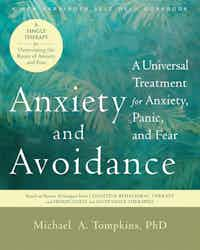How can transdiagnostic approaches help treat anxiety disorders? By using wisdom from the new and groundbreaking contribution by Michael Tompkins, PhD: Anxiety and Avoidance: A Universal Treatment for Anxiety, Panic, and Fear.
From a transdiagnostic standpoint, the foundational step in treating anxiety is to help clients change their responses to anxious experiences. The two key factors that maintain anxiety disorders are experiential avoidance and rumination, so these are the first and foremost targets in treatment, says Tompkins. Teaching the client nonjudgmental, present-focused awareness (mindfulness) is the key, as this skill will start to chip away at the power that these two factors have had over him.
Another key factor that maintains anxiety disorders is cognitive misappraisal, or the tendency to interpret things in particular, inflexible ways. For example, people with anxiety disorders tend to overestimate both the likelihood that bad things will happen, and the impact that the bad things might have on them, if they were to happen. This is the anxious mind in action; and, when a client falls into this pattern of thinking and has trouble shifting out of it, he probably spends more time than he’d like feeling anxious. Therefore, a primary goal in helping your client recover from an anxiety disorder is to help him develop more flexible thinking; that is, learn to shift out of this pattern of anxious thinking at will. As he understands more about the unhelpful way in which his mind is interpreting events and situations, he will have more influence over his anxious response. As he learns to question the accuracy of his initial assumptions and conclusions, he’ll become a more flexible thinker, who can consider different ways to respond to an anxiety-evoking event. This core characteristic, which is known as psychological flexibility, the primary goal of acceptance and commitment therapy—is crucial to overcoming the suffering that stems from anxiety disorders. When a client has developed psychological flexibility, he will see that he can act differently, because he will be more willing to tolerate anxiety and step toward, rather than away from, the things that make him anxious.
Another key factor that fuels and maintains anxiety disorders is response persistence, or the rigid ways in which the client decreases his anxious response when triggered. Checking locks or doors repeatedly because he fears someone will break into his home, for example, or asking others repeatedly to assure him that he is not ill, or sticking to safe topics because he is worried he may say the wrong thing in a social situation, are all examples of anxious actions. These “anxious actions” are behaviors that are anxiety-driven, and while they temporarily decrease his anxiety, they make it harder for him to resist doing them when he feels anxious again. When gone unchecked, the anxious actions become second nature, and it becomes still harder to resist doing them. Furthermore, the more the client does them, the less tolerance he has to feeling even low levels of anxiety.
Anxious actions also make it difficult for the client to learn that he is not in real danger, even when he thinks he is. For example, he can’t learn that people will not harshly criticize him for his opinions if he never shares these opinions with others. Resisting the pull of anxious actions is a challenge, but it can be overcome.
In addition to engaging in anxious actions, which a client may do when his anxiety is triggered, he may also avoid triggering the anxious response, which is an example of response persistence. The client is stuck in a behavioral rut in which he acts in the same anxious way—escape or avoid—even when it doesn’t work. Avoiding making eye contact with people, traveling far from home, or procrastinating starting a task are all examples of the ways that people with anxiety disorders avoid triggering their anxious responses. To recover from an anxiety disorder, though, it is essential that your client enhance his tolerance of the anxious response. When he is confident that he can handle the response, even when his anxiety is quite high, he won’t go out of his way to avoid triggering it. Typically it is the tendency to avoid an anxious response that makes life hard, not the anxious response itself. Learning to step toward discomfort will be a significant help to overcoming an anxiety disorder.
Being unwilling to step toward discomfort, a common issue among people with anxiety disorders, is another one of the key factors that maintains an anxiety disorder. For the client, to face fears and remain in situations that make him uncomfortable is not easy, but helping him to develop the core skills of nonjudgmental, present-focused awareness, and changing the way he interprets events, will increase his willingness to approach his fears and resist the anxious actions that he uses to decrease the anxiety.
True willingness to overcome an anxiety disorder rests on the desire to connect with what is truly important. We’ll go further into the importance of values later, but bear in mind that if you encourage your client to let his values lead the way, he will be more likely to stay on track with recovery, because he will remember the real reason why he’s doing the hard work of building skills for psychological flexibility in the first place.
Michael A. Tompkins, PhD, ABPP, is a board-certified psychologist in behavioral and cognitive psychology. He is codirector of the San Francisco Bay Area Center for Cognitive Therapy; and assistant clinical professor of psychology at the University of California, Berkeley. Tompkins is author or coauthor of twelve books, including Anxiety and Avoidance. Tompkins has presented over 600 workshops, lectures, and keynote addresses on cognitive behavioral therapy (CBT) and related topics nationally and internationally. He is an adjunct faculty member of the Beck Institute for Cognitive Behavior Therapy.



 Why Journaling Is Especially Helpful to Adult Children of Emotionally Immature Parents
Why Journaling Is Especially Helpful to Adult Children of Emotionally Immature Parents